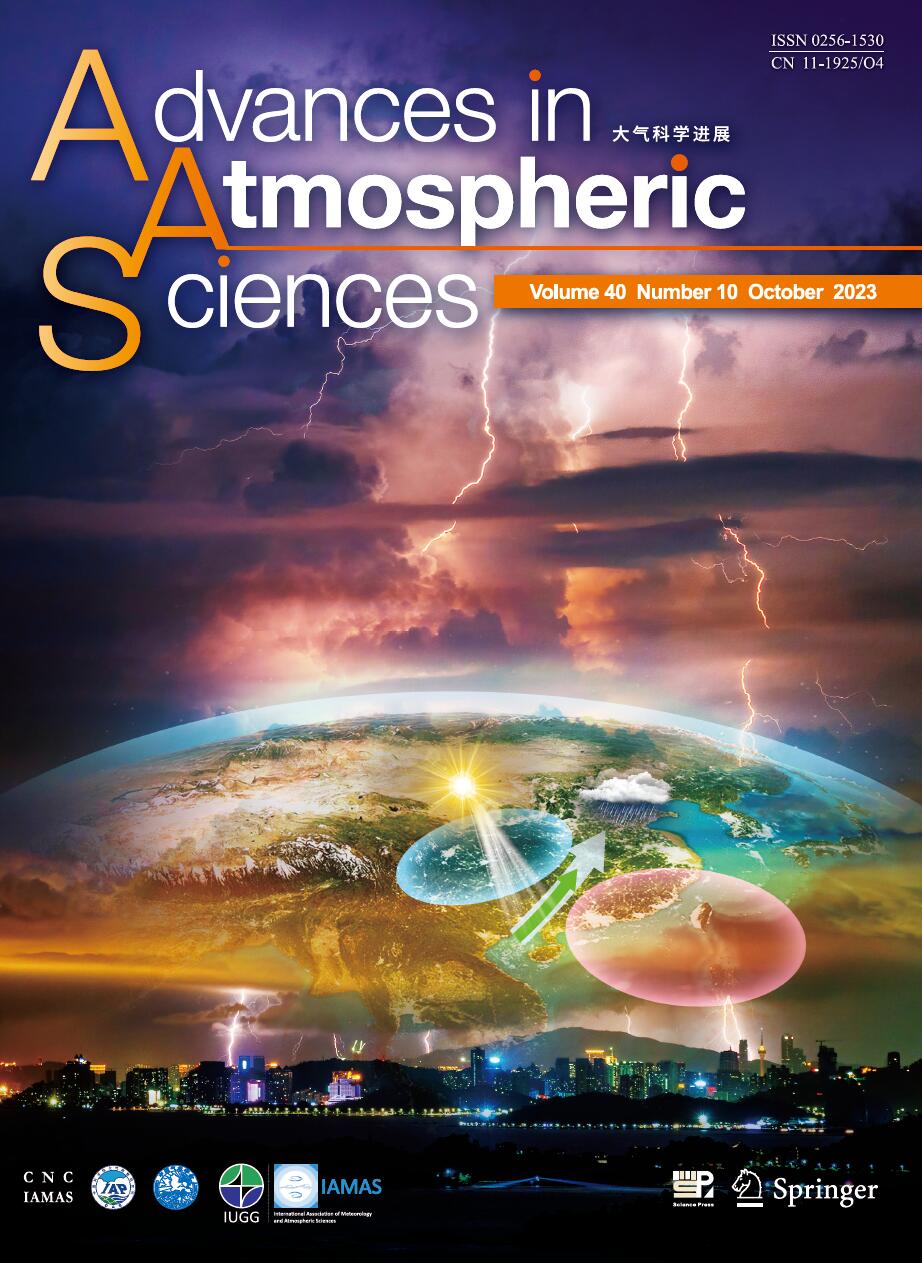| [1] |
Zhengyu LIU,
2006: Glacial Thermohaline Circulation and Climate: Forcing from the North or South?, ADVANCES IN ATMOSPHERIC SCIENCES, 23, 199-206.
doi: 10.1007/s00376-006-0199-7
|
| [2] |
MA Hao, WU Lixin, LI Chun,
2010: The Role of Southern High Latitude Wind Stress in Global Climate, ADVANCES IN ATMOSPHERIC SCIENCES, 27, 371-381.
doi: 10.1007/s00376-009-9047-x
|
| [3] |
YU Yongqiang, ZHENG Weipeng, WANG Bin, LIU Hailong, LIU Jiping,
2011: Versions g1.0 and g1.1 of the LASG/IAP Flexible Global Ocean--Atmosphere--Land System Model, ADVANCES IN ATMOSPHERIC SCIENCES, 28, 99-117.
doi: 10.1007/s00376-010-9112-5
|
| [4] |
ZhouTianjun, Zhang Xuehong, Yu Yongqiang, Yu Rucong, Liu Xiying, Jin Xiangze,
2000: Response of IAP/ LASG GOALS Model to the Coupling of Air-Sea Fresh Water Exchange, ADVANCES IN ATMOSPHERIC SCIENCES, 17, 473-486.
doi: 10.1007/s00376-000-0037-2
|
| [5] |
Jin Xiangze, Huang Ruixin, Yang Jiayan,
1999: Centennial Oscillations in an Ocean-ice Coupled Model, ADVANCES IN ATMOSPHERIC SCIENCES, 16, 323-342.
doi: 10.1007/s00376-999-0012-5
|
| [6] |
BAI Jie, GE Quansheng, DAI Junhu,
2011: The Response of First Flowering Dates to Abrupt Climate Change in Beijing, ADVANCES IN ATMOSPHERIC SCIENCES, 28, 564-572.
doi: 10.1007/s00376-010-9219-8
|
| [7] |
LU Riyu, Buwen DONG,
2008: Response of the Asian Summer Monsoon to Weakening of Atlantic Thermohaline Circulation, ADVANCES IN ATMOSPHERIC SCIENCES, 25, 723-736.
doi: 10.1007/s00376-008-0723-z
|
| [8] |
Jianhua LU, Tapio SCHNEIDER,
2017: Evolving Perspectives on Abrupt Seasonal Changes of the General Circulation, ADVANCES IN ATMOSPHERIC SCIENCES, 34, 1185-1194.
doi: 10.1007/s00376-017-7068-4
|
| [9] |
Xiaoxin WANG, Dabang JIANG, Xianmei LANG,
2018: Climate Change of 4°C Global Warming above Pre-industrial Levels, ADVANCES IN ATMOSPHERIC SCIENCES, 35, 757-770.
doi: 10.1007/s00376-018-7160-4
|
| [10] |
BUHE Cholaw, Ulrich CUBASCH, LIN Yonghui, JI Liren,
2003: The Change of North China Climate in Transient Simulations Using the IPCC SRES A2 and B2 Scenarios with a Coupled Atmosphere-Ocean General Circulation Model, ADVANCES IN ATMOSPHERIC SCIENCES, 20, 755-766.
doi: 10.1007/BF02915400
|
| [11] |
Luo Zhexian,
1987: ABRUPT CHANGE OF FLOW PATTERN IN BAROCLINIC ATMOSPHERE FORCED BY JOINT EFFECTS OF DIABATIC HEATING AND OROGRAPHY, ADVANCES IN ATMOSPHERIC SCIENCES, 4, 137-144.
doi: 10.1007/BF02677060
|
| [12] |
Nitima ASCHARIYAPHOTHA, Prungchan WONGWISES, Somchai WONGWISES, Usa Wannasingha HUMPHRIES, YOU Xiaobao,
2008: Simulation of Seasonal Circulations and Thermohaline Variabilities in the Gulf of Thailand, ADVANCES IN ATMOSPHERIC SCIENCES, 25, 489-506.
doi: 10.1007/s00376-008-0489-3
|
| [13] |
ZHOU Botao, WANG Huijun,
2008: Interdecadal Change in the Connection Between Hadley Circulation and Winter Temperature in East Asia, ADVANCES IN ATMOSPHERIC SCIENCES, 25, 24-30.
doi: 10.1007/s00376-008-0024-6
|
| [14] |
Zhao Ming, Zeng Xinmin,
2002: A Theoretical Analysis on the Local Climate Change Induced by the Change of Landuse, ADVANCES IN ATMOSPHERIC SCIENCES, 19, 45-63.
doi: 10.1007/s00376-002-0033-9
|
| [15] |
Li Chongyin, Mu Mingquan,
2001: The Influence of the Indian Ocean Dipole on Atmospheric Circulation and Climate, ADVANCES IN ATMOSPHERIC SCIENCES, 18, 831-843.
|
| [16] |
S. PANCHEV, T. SPASSOVA,
2005: Simple General Atmospheric Circulation and Climate Models with Memory, ADVANCES IN ATMOSPHERIC SCIENCES, 22, 765-769.
doi: 10.1007/BF02918720
|
| [17] |
REN Guoyu, DING Yihui, ZHAO Zongci, ZHENG Jingyun, WU Tongwen, TANG Guoli, XU Ying,
2012: Recent Progress in Studies of Climate Change in China, ADVANCES IN ATMOSPHERIC SCIENCES, 29, 958-977.
doi: 10.1007/s00376-012-1200-2
|
| [18] |
Wenshou TIAN, Jinlong HUANG, Jiankai ZHANG, Fei XIE, Wuke WANG, Yifeng PENG,
2023: Role of Stratospheric Processes in Climate Change: Advances and Challenges, ADVANCES IN ATMOSPHERIC SCIENCES, 40, 1379-1400.
doi: 10.1007/s00376-023-2341-1
|
| [19] |
SUN Guodong, MU Mu,
2011: Response of a Grassland Ecosystem to Climate Change in a Theoretical Model, ADVANCES IN ATMOSPHERIC SCIENCES, 28, 1266-1278.
doi: 10.1007/s00376-011-0169-6
|
| [20] |
Ge Ling, Liang Jiaxing, Chen Yiliang,
1996: Spatial / Temporal Features of Antarctic Climate Change, ADVANCES IN ATMOSPHERIC SCIENCES, 13, 375-382.
doi: 10.1007/BF02656854
|















 AAS Website
AAS Website 
 AAS WeChat
AAS WeChat 
 DownLoad:
DownLoad: